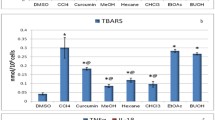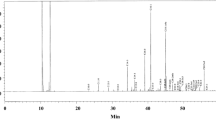Abstract
Pinus densiflora is one of the traditional medicinal plants found in the East Asia, which has a diversity of biological activities including antioxidant effect. The protective effects of a volatile extract from Pinus densiflora (VEPN) against aflatoxin B1 (AFB1)-induced oxidative stress were investigated in human hepatoma cell line, HepG2. Treatment of HepG2 with VEPN significantly reduced the levels of intracellular reactive oxygen species, thiobarbituric acid reactive substances and 8-hydroxy-2′-deoxyguanosine elevated by AFB1, but it increased the level of reduced glutathione. These results indicate that VEPN may afford cytoprotection by attenuating AFB1-induced oxidative stress.
Similar content being viewed by others
References
Massey TE, Stewark RK, Daniel JM, Liu L. Biochemical and molecular aspects of mammalian susceptibility to aflatoxin B1 carcinogenicity. P. Soc. Exp. Biol. Med. 208: 213–227 (1995)
Guerra MC, Galvano F, Speroni BE, Costa S, Renzulli C, Cervellati R. Cyanidin-3-O-β-glucopyranoside, a natural free-radical scavenger against aflatoxin B1-and ochratoxin A-induced cell damage in a human hepatoma cell line (HepG2) and a human colonic adenocarcinoma cell line (Caco-2). Brit. J. Nutr. 94: 211–220 (2005)
Umarani M, Shanti P, Sachdanandam P. Protective effect of Kalpaamruthaa in combating the oxidative stress posed by aflatoxin B1-induced hepatocellular carcinoma with special reference to flavonoid structure-activity relationship. Liver Int. 28: 200–213 (2008)
Klaunig JE, Xu Y, Isenberg JS. The role of oxidative stress in chemical carcinogenesis. Environ. Health Persp. 106: 289–295 (1998)
Eaton DL, Ramsdell HS, Neal GE. Biotransformation of aflatoxins. pp. 45–72. In: The Toxicology of Aflatoxins: Human Health, Veterinary and Agricultural Significance. Eaton DL, Groopman DJ (eds). Academic Press, San Diego, CA, USA (1994)
Shen HM, Shi C-Y, Shen Y, Ong C-N. Detection of elevated reactive oxygen species level in cultured rat hepatocytes treated with aflatoxin B1. Free Radical Bio. Med. 21: 139–146 (1996)
Shen HM, Ong CN, Shi CY. Involvement of reactive oxygen species in aflatoxin B1-induced cell injury in cultured rat hepatocytes. Toxicology 99: 115–123 (1995)
Shen HM, Ong CN, Lee BL, Shi CY. Aflatoxin B1-induced 8-hydroxy deoxyguanosine formation in rat hepatic DNA. Carcinogenesis 16: 419–422 (1995)
Amstad P, Levy A, Emerit I, Ceruti P. Evidence for membrane-mediated chromosomal damage by AFB1 in human lymphocytes. Carcinogenesis 5: 719–723 (1984)
Chun HS, Kim J-M, Choi EH, Chang N. Neuroprotective effects of several Korean medicinal plants traditionally used for stroke remedy. J. Med. Food 11: 246–251 (2008)
Ka M-H, Choi EH, Chun HS, Lee K-G. Antioxdative activity of volatile extracts isolated from angelica tenuissimae roots, peppermint leaves, pine needles, and sweet flag leaves. J. Agr. Food Chem. 53: 4124–4129 (2005)
Kwak CS, Moon SC, Lee MS. Antioxidant, antimutagenic, and antitumor effects of pine needles (Pinus densiflora). Nutr. Cancer 56: 162–171 (2006)
Hong E-J, Na K-J, Choi I-G, Choi K-C, Jeung E-B. Antibacterial and antifungal effects of essential oils from coniferous trees. Biol. Pharm. Bull. 27: 863–866 (2004)
Kuribara H, Tomioka H, Takahashi R, Onozato K, Murohashi N, Numajiri T, Iwata H, Koya S. An antidepressant effect of sho-jusen, a Japanese herbal medicine, assessed by learned helplessness model in mice. Phytother. Res. 18: 173–176 (2004)
Jung MJ, Chung HY, Choi JH, Choi JS. Antioxidant principles from the needles of red pine, Pinus densiflora. Phytother. Res. 17: 1064–1068 (2003)
Choi E-M. Antinociceptive and anti-inflammatory activities of pine (Pinus densiflora) pollen extract. Phytother. Res. 21: 471–475 (2007)
Lee J-K, Choi EH, Lee K-G, Chun HS. Alleviation of aflatoxin B1-induced oxidative stress in HepG2 cells by volatile extract from Allii Fistulosi Bulbus. Life Sci. 77: 2896–2910 (2005)
Denizat F, Lang R. Rapid colorimetric assay for cell growth and survival: Modifications to the tetrazolium dye procedure giving improved sensitivity and reliability. J. Immunol. Methods 89: 271–277 (1986)
Osseni RA, Debbasch C, Christen M-O, Rat P, Warnet J-M. Tacrine-induced reactive oxygen species in a human dithiolethione as a scavenger. Toxicol. In Vitro 13: 683–688 (1999)
Murakami C, Hirakawa Y, Inui H, Nakano Y, Yoshida H. Effect of tea catechin on cellular lipid peroxidation and cytotoxicity in HepG2 cells. Biosci. Biotech. Bioch. 66: 1559–1562 (2002)
Chouchane S, Guignard J, Fournier J. Lipid peroxidation in the presence of iron oxides. Toxicol. Environ. Chem. 75: 43–57 (2000)
Armstrong D. Free radical and antioxidant protocols. pp. 181–190. In: Methods in Molecular Biology. Armstrong D (ed). Humana Press, Totowa, NJ, USA (1998)
Chan H-T, Chan C, Ho JW. Inhibition of glycyrrhizic acid on aflatoxin B1-induced cytotoxicity in hepatoma cells. Toxicology 188: 211–217 (2003)
Uenz YF, Shimada T, Yanazaki H, Guengerich FP. Oxidation of aflatoxin B1 by bacterial recombinant human cytochtome P450 enzymes. Chem. Res. Toxicol. 8: 218–225 (1995)
Costa S, Utan A, Speroni E, Cervellati R, Piva G, Prandini A, Guerra MC. Carnosic acid from rosemary extracts: A potential chemoprotective agent against aflatoxin B1. An in vitro study. J. Appl. Toxicol. 27: 152–159 (2007)
Santella RM. DNA damage as an intermediate biomarker in intervention studies. Exp. Biol. Med. 216: 166–171 (1997)
Author information
Authors and Affiliations
Corresponding author
Rights and permissions
About this article
Cite this article
Lee, JK., Chang, HJ. & Chun, H.S. Protective effect of volatile extract from Pinus densiflora against aflatoxin B1-induced oxidative stress in HepG2 cells. Food Sci Biotechnol 19, 229–233 (2010). https://doi.org/10.1007/s10068-010-0031-0
Received:
Revised:
Accepted:
Published:
Issue Date:
DOI: https://doi.org/10.1007/s10068-010-0031-0




